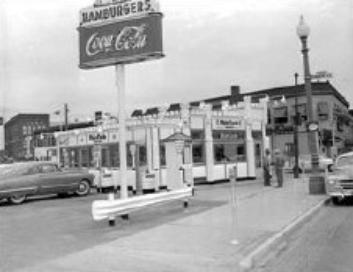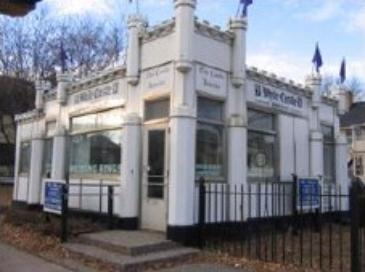The White Castle Building is an example of the company’s iconic fast food hamburger stand. This was the first successful use of porcelain enamel over steel as an architectural material.
E.W. Engram founded White Castle Corporation in Wichita, Kansas, in 1921. It was the first fast food chain. The company was known for its five-cent “sliders.” Key business supplies included square hamburger buns, large quantities of fresh ground beef, specialized appliances, and disposable linens. White Castle developed ways to pack meat, bake buns, make paper linens, and fabricate steel for its own use. It ushered in a new era of mass production.
The desired building needed to be portable. Landowners did not like to lease small sites for long term usage, so the company needed to be able to move it. The design was modeled after the medieval Chicago Water Tower. The rolled steel panel walls are covered with porcelain enamel. The crenellated towers and parapet wall emphasize the castle-like appearance. It is an example of Programmatic architecture, when a building looks like a familiar object.
Between 1926 and 1942, 55 portable castle buildings were produced. This was the eighth one made. It was built at the company’s steel fabricating plant in Columbus, Ohio, and installed in Minneapolis in 1936. Its first location was 616 Washington Avenue Southeast. In 1950, when the lease expired, it was moved to 329 Central Avenue Southeast. A full basement with a bathroom was added. A 6-foot by 28-foot addition was built for a customer pickup area. In 1983, the restaurant closed and was scheduled for demolition. A group of people bought the building to preserve it. They moved it to its current location on Lyndale Avenue South in 1984.



